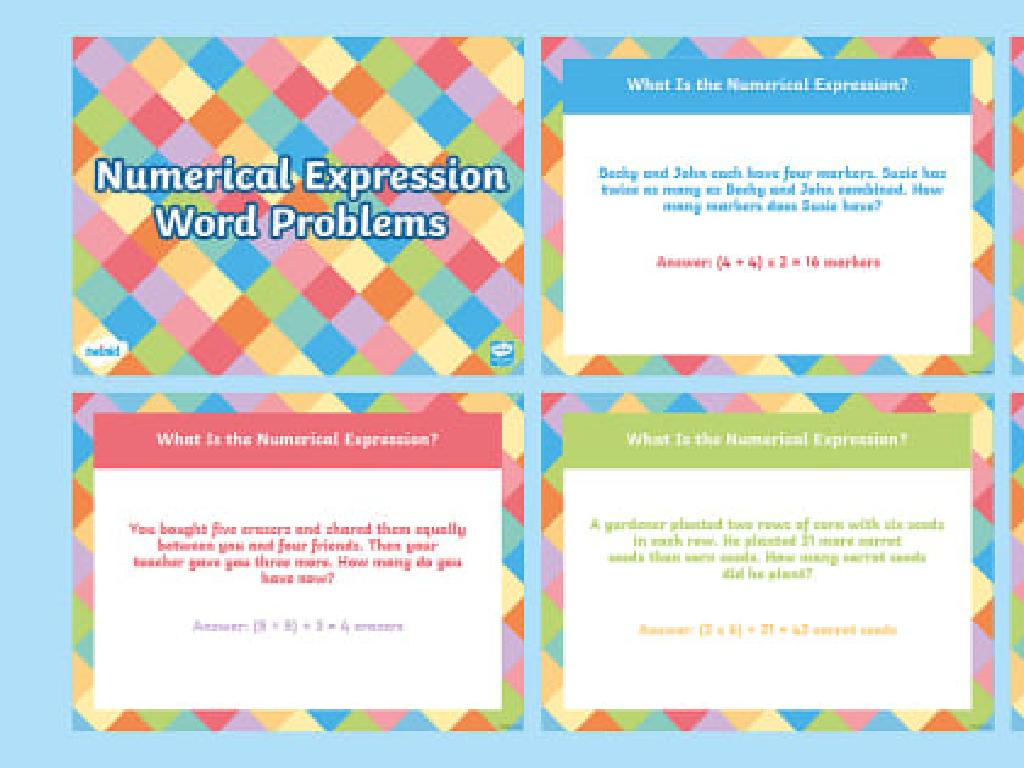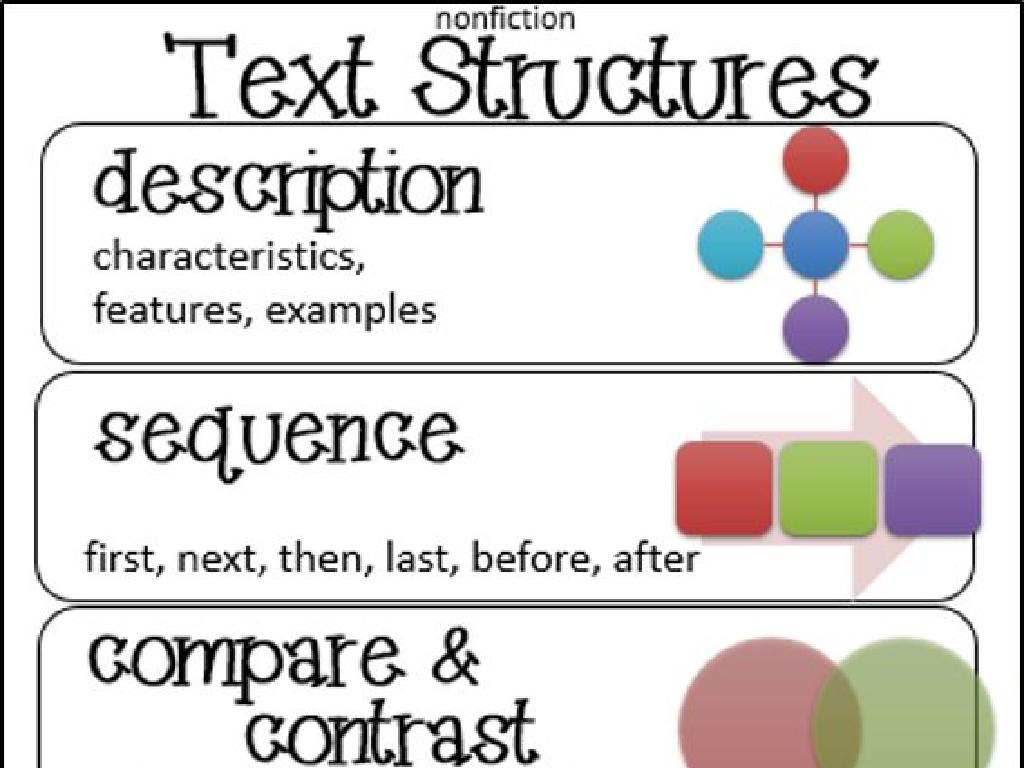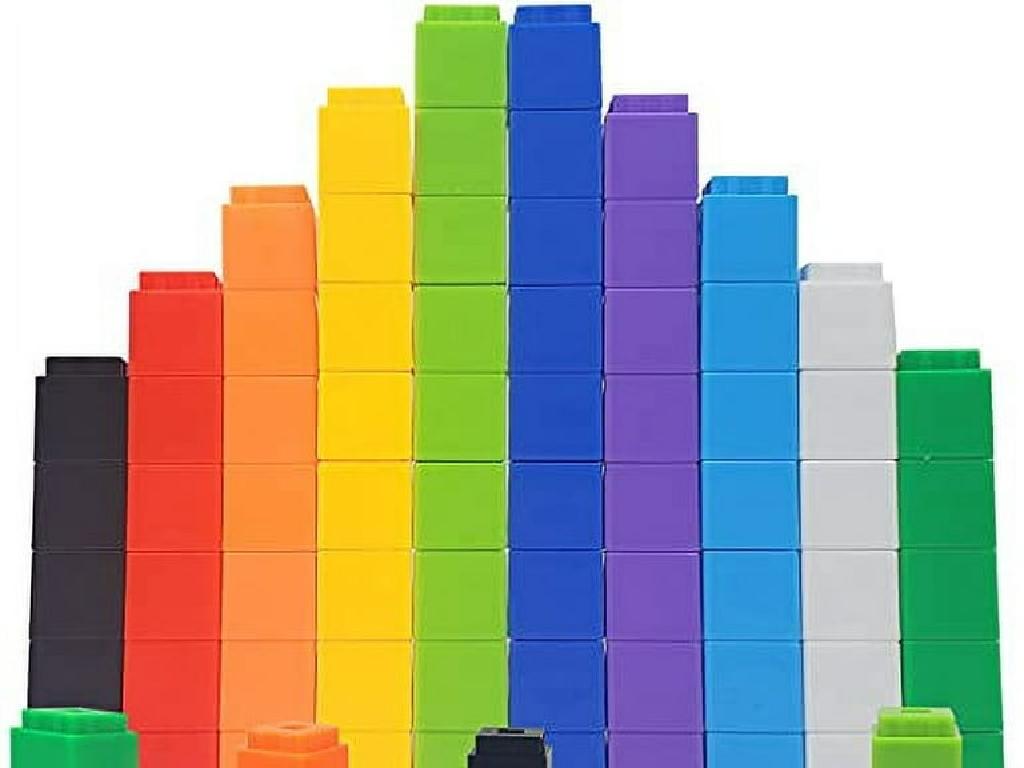Use Regular Plurals With -S, -Es, And -Ies
Subject: Language arts
Grade: Fourth grade
Topic: Nouns
Please LOG IN to download the presentation. Access is available to registered users only.
View More Content
Welcome to Nouns and Their Plurals!
– Greeting and topic introduction
– Understanding nouns
– A noun is a person, place, thing, or idea
– Singular vs. plural nouns
– Singular noun: one item, plural noun: more than one
– Significance of plural forms
– Knowing plurals helps in writing and speaking correctly
|
Begin the class with a warm welcome and introduce the topic of nouns and their plural forms. Explain that a noun represents a person, place, thing, or idea, and it’s one of the fundamental building blocks of language. Discuss the difference between singular and plural nouns, emphasizing that singular refers to one item while plural refers to more than one. Highlight the importance of using the correct plural forms to ensure clear and correct communication in both writing and speaking. Engage the students with examples and encourage them to think of their own nouns and convert them into plural forms using -s, -es, and -ies.
Singular vs. Plural Nouns
– What are singular nouns?
– A singular noun means one item, like ‘dog’ or ‘cat’.
– Turning singular to plural
– Add ‘s’, ‘es’, or ‘ies’ to make most nouns plural, like ‘dogs’ or ‘buses’.
– Visual cues for plurals
– Plurals often have a letter added at the end, changing their look and sound.
– Practice with examples
– Let’s look at ‘city’ becoming ‘cities’ and ‘fox’ turning into ‘foxes’.
|
This slide introduces the concept of singular and plural nouns to fourth-grade students. Begin by defining a singular noun as a word that refers to one item. Then, explain how to form plurals by adding ‘s’, ‘es’, or ‘ies’, depending on the ending of the singular noun. Use visual aids to highlight the difference in spelling between singular and plural forms. Provide clear examples, such as ‘city’ to ‘cities’ and ‘fox’ to ‘foxes’, to illustrate the rules. Encourage students to come up with their own examples and write them down for practice. The goal is for students to recognize and use regular plural forms confidently in their writing and speech.
Making Plurals with -s
– Basic rule for adding -s
– Add -s to most nouns to show more than one, like ‘cat’ to ‘cats’.
– Examples of simple plurals
– Words like ‘dog’, ‘car’, ‘house’ just need an -s to be plural.
– Class practice with plurals
– Let’s turn ‘apple’, ‘book’, and ‘chair’ into plurals together.
|
This slide introduces the concept of forming plural nouns by adding -s. Start by explaining that in most cases, simply adding an -s to the end of a noun makes it plural, which means more than one. Provide clear examples of common nouns that follow this rule. Engage the class with an interactive activity where they convert given singular nouns to plural. This practice helps reinforce the rule and allows students to apply what they’ve learned. Encourage students to come up with their own examples and correct any misconceptions about pluralization.
Plural Nouns: When to Add -es
– Rule for -es: s, x, z, ch, sh endings
– Add -es to nouns ending with s, x, z, ch, sh
– Examples: bus -> buses, box -> boxes
– More examples: buzz -> buzzes, church -> churches
– Practice with class: dish -> dishes
– Interactive class activity to reinforce learning
– Note exceptions: mouse -> mice
– Discuss irregular plurals and common errors
|
This slide introduces the rule for adding -es to make regular plurals. Focus on nouns ending in s, x, z, ch, and sh. Provide clear examples for each case and engage the class with practice exercises to apply the rule. Highlight the importance of recognizing patterns in pluralization. Address common exceptions to the rule, such as ‘mouse’ becoming ‘mice’, to prepare students for irregular plural forms. Encourage students to think of additional examples and share them with the class. This will help solidify their understanding and ability to use plurals correctly in writing and speech.
Plural Nouns: Changing -y to -ies
– Rule: -y to -ies after consonants
– If a noun ends in a consonant + y, change y to i and add -es
– Examples: baby to babies
– city becomes cities, puppy becomes puppies
– Practice with provided words
– Try converting: cherry, lady, party
– Understand exceptions to the rule
– Words ending in -ay, -ey, -oy, -uy use -s: boys, days
|
This slide introduces the grammatical rule for forming plurals of nouns ending in -y preceded by a consonant, which is to change -y to -ies. Start by explaining the rule and providing clear examples. Then, engage the students with a practice activity where they apply the rule to a list of words. Highlight common exceptions to ensure students understand that not all words ending in -y will follow the same pattern, such as ‘keys’ or ‘monkeys’. This will help them recognize patterns and improve their spelling skills. Encourage students to come up with additional examples and to understand the reason behind the rule.
Let’s Practice Plurals!
– Engage with a plural form quiz
– Explain your choice: -s, -es, -ies
– For example, why ‘buses’ not ‘buss’? Discuss the rules.
– Discuss and correct misconceptions
– Use examples to clarify why some answers might be incorrect.
– Provide positive feedback
|
This interactive slide is for a class activity where students will participate in a quiz to practice the plural forms of nouns. The quiz should include a variety of nouns that take different plural endings (-s, -es, -ies). After each question, ask students to explain the rule that applies. This will help them understand the concept better and remember it. Correct any misconceptions immediately in a supportive manner, ensuring that the student understands the correct usage. Always provide positive feedback to encourage participation and make the learning process enjoyable. Possible activities: 1) Matching singular with plural forms, 2) Correcting sentences with plural mistakes, 3) Creating plural forms from a list of singular nouns, 4) Writing sentences using new plural words, 5) A ‘plural form’ spelling bee.
Class Activity: Plural Scavenger Hunt
– Understand scavenger hunt rules
– Find objects and note singular/plural
– For example, book becomes books, box becomes boxes, and baby becomes babies
– Discuss findings with the class
– Review and correct any mistakes
– We’ll learn from each other’s discoveries and corrections
|
This interactive activity is designed to help students apply their knowledge of forming regular plurals using -s, -es, and -ies. Begin by explaining the rules of the scavenger hunt: students must look around the classroom to find objects they can write in both singular and plural forms. Encourage them to consider the ending of each singular noun to determine the correct plural form. After the hunt, regroup and discuss the findings. This will be a collaborative learning experience where students can see common patterns and learn from any mistakes made. As a teacher, prepare to guide the discussion, offering praise for correct answers and gentle corrections where needed. Possible variations of the activity could include working in pairs, setting a time limit, or categorizing the objects found.
Wrapping Up: Plurals and Homework
– Review: Making nouns plural
– Remember, add -s or -es for most, -ies for words ending in ‘y’
– Homework: Craft 10 sentences
– Create sentences with plural nouns you’ve learned
– Use -s, -es, and -ies correctly
– Check if the noun ends with -ch, -sh, -s, -x, or -z and use -es; if it ends with a consonant + y, use -ies
– Share sentences next class
|
As we conclude today’s lesson on plural nouns, recap the rules for adding -s, -es, and -ies. For homework, students should write 10 sentences that include a variety of plural nouns, applying the rules we’ve learned. Encourage creativity and the use of different noun endings to ensure they practice each rule. In the next class, we’ll share some of these sentences to reinforce learning and celebrate their efforts. Provide examples like ‘bus’ to ‘buses’, ‘fox’ to ‘foxes’, and ‘baby’ to ‘babies’ to guide them.






